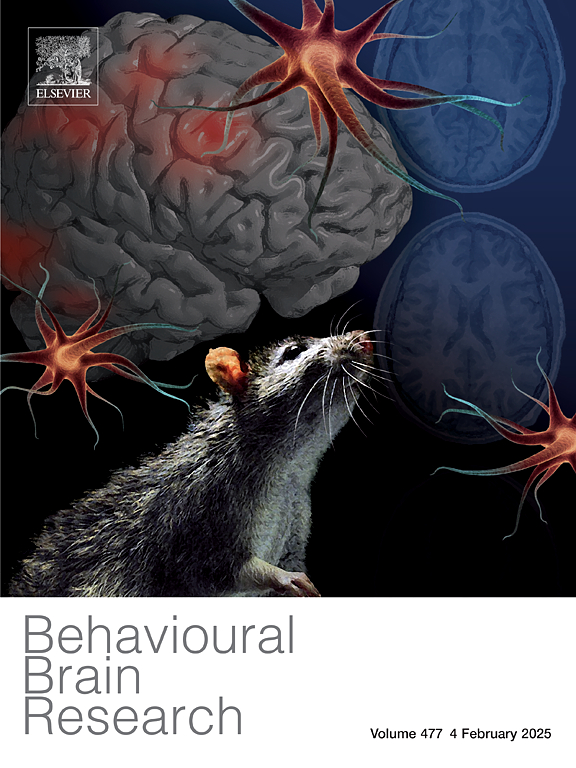Differential actions of ketamine on CA3-prelimbic and CA3-infralimbic connection responsivity depend on prior exposure to stress
IF 2.3
3区 心理学
Q2 BEHAVIORAL SCIENCES
引用次数: 0
Abstract
The present study explored the behavioral stressing action of a 15-min forced swim test (FST) session, changes in CA3-medial prefrontal cortex (mPFC) connection responsivity, and whether ketamine reverses such changes. Two groups of male Wistar rats were subjected to a 15-min FST session. Sixty minutes later, they were injected with either saline (stress [STR] SAL group) or ketamine (STR KET group). Twenty-four hours later, these two groups underwent an open field test (OFT) and a 5-min FST session. The other two groups received similar treatments (SAL group and KET group) without being subjected to the FST. In all four groups, single-unit extracellular recordings from the prelimbic (PL) and infralimbic (IL) regions of the mPFC were obtained while the CA3 hippocampal region was stimulated. Ketamine decreased the time spent immobile in the FST without altering behavior in the OFT. In the SAL group, CA3 stimulation produced an inhibitory response in the PL but a strong excitatory response in the IL. In the KET group, there were no changes in connection responsivity in the CA3-PL connection, but an inhibitory response was observed in the CA3-IL connection. Responsivity of the CA3-PL connection was similar between the STR KET and STR SAL groups. In the SAL group, CA3 stimulation produced an inhibitory response in the IL, which was accentuated in the STR SAL group. In the STR KET group, the inhibitory response was abolished. These findings indicate that the CA3-PL connection is sensitive to stress, independent of drug treatment, whereas the CA3-IL connection is sensitive to ketamine, but its action depends on prior stress exposure.
氯胺酮对ca3 -边缘前和ca3 -边缘下连接反应的不同作用取决于先前的应激暴露
本研究探讨了15分钟强迫游泳测试(FST)会话的行为应激作用,ca3 -内侧前额叶皮层(mPFC)连接反应性的变化,以及氯胺酮是否能逆转这种变化。两组雄性Wistar大鼠进行15分钟的FST训练。60分钟后,分别注射生理盐水(应激[STR] SAL组)或氯胺酮(STR] KET组)。24小时后,这两组进行了开放场测试(OFT)和5分钟的FST会话。另外两组(SAL组和KET组)给予相同的治疗,不进行FST。在所有四组中,当海马CA3区受到刺激时,从mPFC的边缘前区(PL)和边缘下区(IL)获得了单个单元的细胞外记录。氯胺酮减少了FST中静止不动的时间,而不改变OFT中的行为。在SAL组中,CA3刺激在PL中产生抑制反应,而在IL中产生强烈的兴奋反应。在KET组中,CA3-PL连接的连接反应没有变化,但在CA3-IL连接中观察到抑制反应。在STR - KET组和STR - SAL组之间,CA3-PL连接的响应性相似。在SAL组中,CA3刺激在IL中产生抑制反应,这在STR SAL组中得到加强。在STR - KET组,抑制反应被消除。这些发现表明CA3-PL连接对应激敏感,与药物治疗无关,而CA3-IL连接对氯胺酮敏感,但其作用取决于先前的应激暴露。
本文章由计算机程序翻译,如有差异,请以英文原文为准。
求助全文
约1分钟内获得全文
求助全文
来源期刊

Behavioural Brain Research
医学-行为科学
CiteScore
5.60
自引率
0.00%
发文量
383
审稿时长
61 days
期刊介绍:
Behavioural Brain Research is an international, interdisciplinary journal dedicated to the publication of articles in the field of behavioural neuroscience, broadly defined. Contributions from the entire range of disciplines that comprise the neurosciences, behavioural sciences or cognitive sciences are appropriate, as long as the goal is to delineate the neural mechanisms underlying behaviour. Thus, studies may range from neurophysiological, neuroanatomical, neurochemical or neuropharmacological analysis of brain-behaviour relations, including the use of molecular genetic or behavioural genetic approaches, to studies that involve the use of brain imaging techniques, to neuroethological studies. Reports of original research, of major methodological advances, or of novel conceptual approaches are all encouraged. The journal will also consider critical reviews on selected topics.
 求助内容:
求助内容: 应助结果提醒方式:
应助结果提醒方式:


